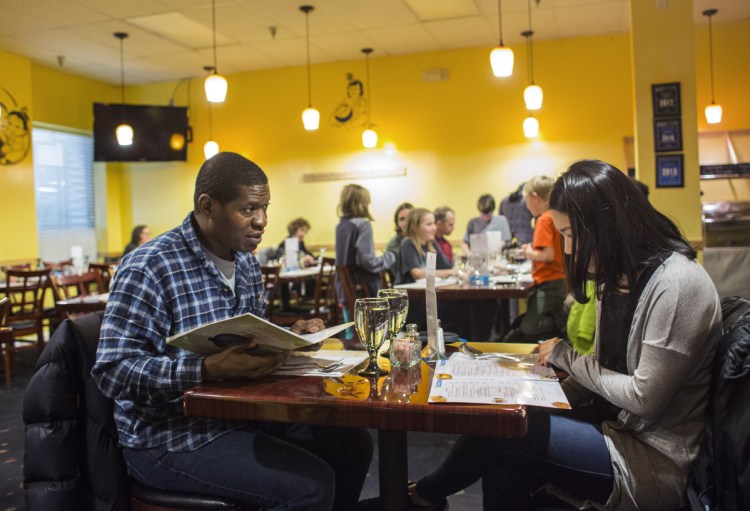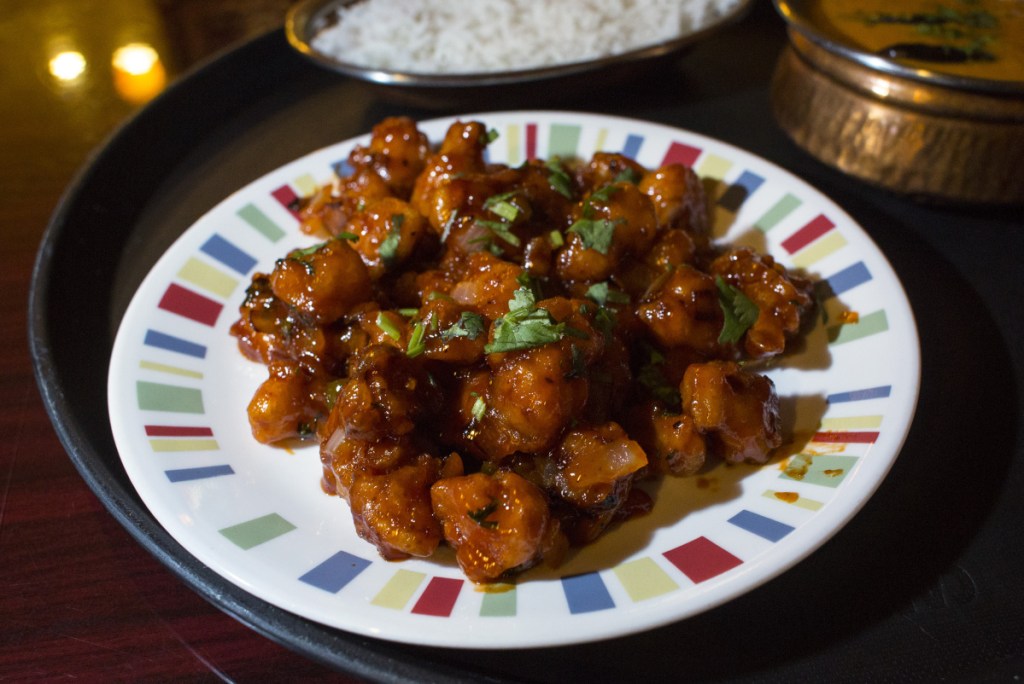If you didn’t know better, you might think of South Portland’s Taj as a single restaurant: a no-frills, strip-mall storefront in the Clarks Pond neighborhood. But inside, several conflicting personalities are waging a campaign for control.
Come at lunchtime and you’ll spy chafing dishes of curries and rice lining the back wall of the ochre dining room, all part of a cheap-and-cheerful buffet that is filling, but not much more than that. When night falls, Taj reveals grander ambitions as it transforms into a full-service, “Indian & Indo Chinese” restaurant. Yet even the restaurant’s dinner menu belies an uncertain commitment to its stated culinary focus. Amid dozens and dozens of mainly South Indian dishes is a comically brief Indo-Chinese section. Population: two dishes.
One is fried rice ($9.99), and the other is Hakka noodles ($9.99) a dish based on Chinese lo mein. With stir-fried shredded cabbage and carrots, onions and an egg scrambled into the mix, the dish looks and tastes, disappointingly, exactly like fried rice, only prepared with wheat noodles in place of rice.
If you’re committed to searching through the overly expansive menu, you will find other dishes with a Chinese connection, but only a few. One is gobi Manchuria ($7.99), a cracklingly spicy appetizer of cauliflower florets dredged in a chickpea flour batter, then deep-fried and tossed in soy sauce, ketchup, chili powder, ginger and garlic. A mixed-vegetable ($8.99) and chicken ($8.99) version of the same dish round out Taj’s perfunctory selection of Indo-Chinese offerings.
Moreover, as good as the gobi Manchuria is, the purely Indian version, gobi 65 ($7.99) is better. Here, those same deep-fried florets of cauliflower get lacquered with a tangy sauce made from chili, lime juice and chef/owner Latha Guntaka’s housemade yogurt. The balance between cooling dairy and fiery heat is fantastic.
For the capsaicin-phobic, Guntaka and her kitchen staff generally do well moderating spice to accommodate individual preferences, although nothing I have tasted at Taj was spicier than a Flamin’ Hot Cheeto.
Some of the restaurant’s dishes are mild by design, like chana masala ($9.99), made with chickpeas stewed in tomatoes, garlic-ginger paste, coriander and cumin. Guntaka leaves a little al-dente bite to her chickpeas – a nice touch that keeps the dish from going mushy.
And as well as the chana masala pairs with a scoop of basmati rice or a torn shred of blistered garlic naan ($2.99), still steaming from the kitchen’s own tandoor (clay oven), its ideal companion is batura, a puffy, Punjabi fried bread.
Batura dough is like a quick bread brioche: It is enriched with clarified butter (ghee), but leavened with yogurt and baking soda rather than yeast. When flattened rounds of dough hit hot oil, they inflate instantly to the size and shape of a volleyball. Inside, the texture is moist, and even a little sticky in places, with tiny cells designed to capture fragrant, tomato-rich sauce from the chickpea stew (sold together with one batura as “Cholle batura,” $8.99).
Another appealing combination plate is the idli vada ($5.99), an appetizer featuring a cup of curried lentil sambhar, two chutneys (coconut and tomato) and a pair of starchy items: one lentil-flour doughnut flecked with cilantro leaves and two steamed idli. Made from a fermented batter of puréed softened rice and skinless lentils, idli are spongy and stark white. Think of them as a triplex cross between a dumpling, a dinner roll and a madeleine. Taj’s are yielding, yet tightly structured – perfect for dipping and sopping.
On my second recent visit, I used one of the idli to mop up the excess sauce from an order of Chettinadu chicken ($11.99), a complex Keralan dish of slow-simmered, boneless strips of chicken in a coconut-milk-thickened sauce spiced with oniony asafoetida and fennel seeds.
While some dishes, especially the homier traditional ones, reveal Guntaka’s keen ability to layer flavors without muddying them, other dishes fall along a spectrum of variable success. Some, like kheer ($2.99), a thin rice pudding bulked up with broken vermicelli, tapioca pearls, chopped cashews and a few golden raisins, forfeit all subtlety with a throat-clutching overdose of cardamom.
Others, like lamb saag ($12.99), made with chunks of lamb shoulder simmered with yogurt and fresh spinach, come to the table undersalted and bland. When one of my dinner guests asked our server for more information about what was in his saag, the server replied, “Meat and spices.” Indeed. That same unhelpful response could be used to describe practically any entrée, made in any city on Earth over the past 4,000 years.

South Indian dishes dominate the menu at Taj, with a few Indo-Chinese offerings.
Unfortunately, this wasn’t the only service issue I encountered at Taj. As I walked in one evening, I spotted another server spritzing down a tabletop with a spray bottle – in the process misting the salt and pepper shakers with chemicals and enraging a diner seated downwind. “You’re getting me and my food!” the freshly sanitized woman cried out in exasperation, before making a hasty exit and leaving behind her leftovers.
I might have left myself, but I wanted to taste one of the Hyderabadi biryanis, one-pot dishes built on a foundation of spiced basmati rice. They’re important enough to Taj that they get a dedicated section of the menu. So I took a seat and ordered the bachi dum biryani ($12.99), a dish only available Fridays through Sundays, thanks to chicken that demands an 18-hour marinade in yogurt, turmeric, onion and ginger. “Sometimes it is finished (sold out) in one night,” the marauding spritzer told me. “But we have it tonight (a Friday). Me, I like it better on Sundays. The chicken is nicer.” Wait too long, he seemed to say, and you risk missing out.
But, as I discovered after a few forkfuls, that’s not the only risk associated with the dish. Hidden among the long grains of golden rice were several paper-clip-sized shards of razor-sharp chicken bone, released when the long drumstick was split before cooking. Yes, cutting the bone allows the marrow inside to impart a meaty depth to the rice, but this careless butchery was a potentially disastrous mistake. A spiky slice of shattered bone could seriously injure someone. Not wanting to be that particular someone, I set my fork down and ordered another helping of fiery fried cauliflower. The vegetable-oriented version of Taj was one I liked – and trusted – a lot more.
Andrew Ross has written about food in the United Kingdom and in New York, where he co-founded NYCnosh, a food website. He and his work have been featured on Martha Stewart Living Radio and in The New York Times. He is an Internet researcher and higher education consultant. Contact him at:
andrewross.maine@gmail.com
Twitter: @AndrewRossME
Send questions/comments to the editors.




Success. Please wait for the page to reload. If the page does not reload within 5 seconds, please refresh the page.
Enter your email and password to access comments.
Hi, to comment on stories you must . This profile is in addition to your subscription and website login.
Already have a commenting profile? .
Invalid username/password.
Please check your email to confirm and complete your registration.
Only subscribers are eligible to post comments. Please subscribe or login first for digital access. Here’s why.
Use the form below to reset your password. When you've submitted your account email, we will send an email with a reset code.